Dr. Z’s All-Time Team: Part I—Offense

This week at The MMQB is dedicated to the life and career of Paul Zimmerman, who earned the nickname Dr. Z for his groundbreaking analytical approach to the coverage of pro football. For more Dr. Z content, click here. Read Part II of his all-time team, the defense and special teams, tomorrow at The MMQB.
Creating an all-time team is ground I’ve plowed many times. But I’m always finding something new. First, bear with me for a moment while I tell you why I don’t like all-star teams, Pro Bowl teams, Coach of the Year awards, Super Bowl MVP trophies. Because they’re just promotions, NFL gimmicks to sell more T-shirts.
Pro Bowl voting is a popularity contest. I have seen high vote-getters who spent two-thirds of the season on injured reserve. Players don’t take the voting seriously, coaches are always busy with something else, fans pack the ballots. Very seldom is the Coach of the Year the Super Bowl winner because the balloting takes place, at all levels, just about when the playoffs are starting. So it’s always the guy who, amazingly, takes his team from 4-12 to the playoffs, and many times not much further. Super Bowl MVP ballots are collected before the final whistle.
And as for all-star teams by such organizations as the AP or the Pro Football Writers, well, these are better than most, but there’s still the subliminal pull of the superstar, the comfort in the known entity. And that’s why, and this will sound like the utmost in arrogance, I have faith in my own All-Pro team every year, compiled by so much tape breakdown that you would start laughing if I laid it all out for you ... my own team and very few others.
But unfortunately I must admit to the demon prejudice, that most personal of all human failings. I’m more careful about this than I used to be, and I try to isolate it and eradicate it before it becomes an embarrassment, but let’s face it. If you become passionate about something, sooner or later you’re going to play favorites. The heroic run, the spectacular defensive play, especially on behalf of the team you happen to be rooting for, will take on a disproportionate significance. An example:
In 1985 I had picked Cincinnati, an eventual 7-9 team, to upset Dallas, which eventually won its division, in a late season game. The affair wasn’t close, 50-24, Cincy, and the Bengals ran for a million yards. Especially notable was the job Cincy’s 23-year old, 300-pound left guard, Brian Blados, did on Hall of Famer Randy White. I didn’t much like the Cowboys anyway ... America’s Team and so forth ... and to see them beaten like that, and to watch the way the fat kid took on White, the most feared interior lineman in the game, just flipped me.
An all-time team is etched in marble. It’s for the ages. And I’ve been doing it for, oh, 63 years.
So I picked Blados on my Sports Illustrated All-Pro team, the only all-star honor of any kind he ever achieved. And I left off John Hannah, one of the greatest offensive linemen in history, but a player who after 13 seasons had reached the end of the trail. And Hannah, with whom I had been fairly friendly, stopped talking to me.
“I mean, Blados?” he said in our last conversation. “Are you kidding? Brian Blados?”
But picking an all-time All-Pro team is different. It’s etched in marble. It’s for the ages. It’s something in which I’ve had a lot of practice because I’ve been doing it for, oh, about 63 years, ever since I got my first taste of the game in the World War II era—Giants vs. the wartime combination of the Steelers and Eagles, nicknamed the Steagles, on Oct.24, 1943, the day after my 11th birthday. The tickets were my father’s birthday present to me.
Next year we went to the Polo Grounds on Oct. 22, the day before my birthday. Giants vs. the Cards-Pitts combination, referred to as the Carpets—they don’t name ’em like that anymore. I started jotting down names of my favorite players, beginning with Al Blozis. The 6'6" tackle was the personal favorite of all New York kids who liked football. He’d been drafted into the army in December of ’43, but he played three games in ’44 while on furlough. I remember the deafening roar of the Polo Grounds fans when his name was announced. I remember reading about how he broke the Army record for the hand grenade throw when he heaved one almost 100 yards at Fort Bennning, Ga. I cut out the article and kept it.
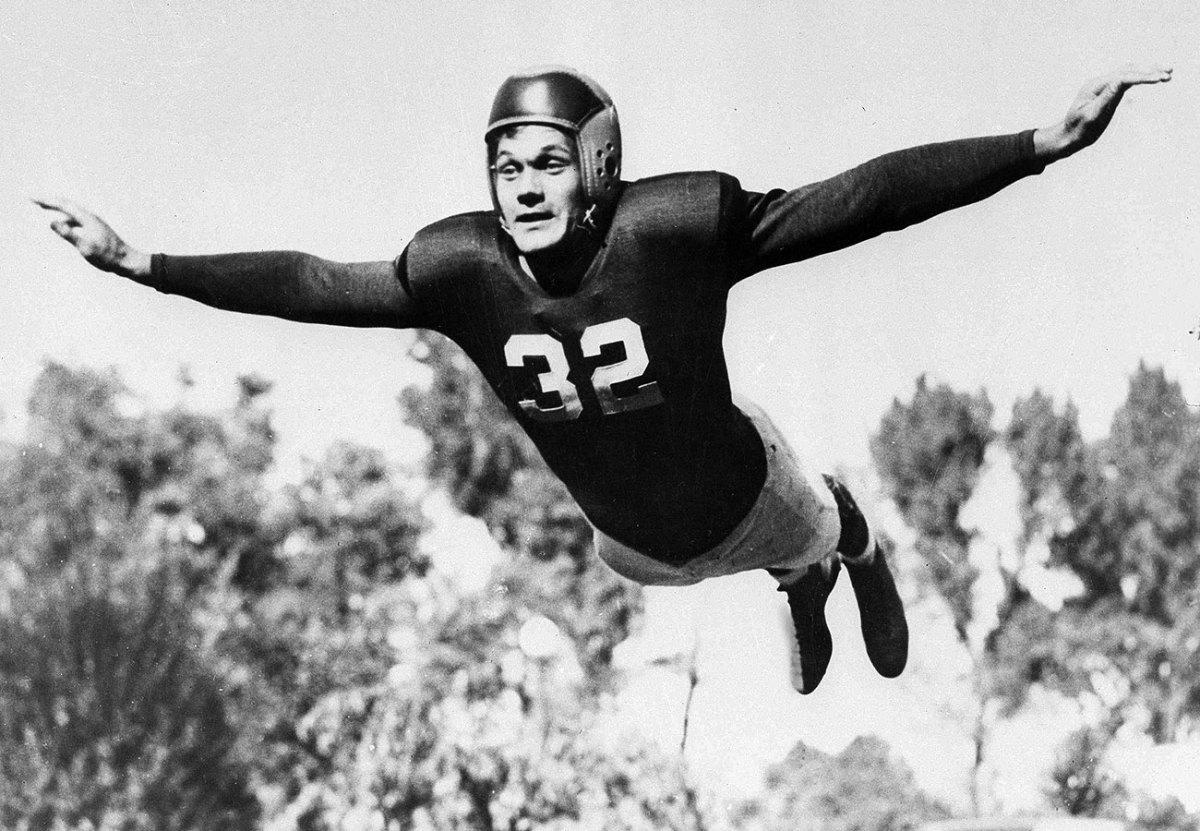
And then in January 1945, Lieutenant Blozis was killed in the Vosges Mountains in Alsace, venturing out, alone, to find a sergeant and private in his command who had gone out on patrol and failed to return. He immediately joined my all-time, All-Pro squad, alongside Giant stars such as Mel Hein, the center-linebacker, and known entities such as Don Hutson and Sammy Baugh, and remained on what became an ongoing list of all stars for a few years. It was only when the cold analysis of the dispassionate chartist, aged 17 or 18 or so, roughly elbowed sentiment aside, that Big Al became a former all-time All-Pro.
Actually I started charting games in 1947, and although players such as Blozis and Hein were, at the time, untouchable on the all-time list, the charts helped me pick my yearly All-Pro teams. For me, they were significant because I was combining the NFL with the AAFC (All-American Football Conference). The bulk of the positions, at least on my club, were filled by AAFC players, which might have been a little unfair because those were the guys I was always watching in the flesh. In my neighborhood, at least, we dug the AFC and our Yankees, with the great triple threat, single wing tailback, Spec Sanders, and tiny Buddy Young, who would bring you out of your seat every time he touched the ball, and tough as nails Bruiser Kinard—now THAT’s the kind of nickname a lineman should have—and in the last year of the league’s existence, a tough, rawboned cornerback, defensive halfback is what they called them in those days, whose strangling style of pass coverage made him an immediate favorite of any New Yorker who loved football, and that was Tom Landry.
It seemed as if the old boys club of the NFL deliberately tried to destroy the heritage of the AAFC. Only when the AFL and NFL merged were the AAFC numbers allowed in by the back door.
So those were the people who populated my All-Pro team, keyed, of course, to the magnificent Cleveland Browns, whom we just knew in our hearts were better than anything the NFL had to offer. But I wasn’t a fanatic on the subject. I understood, of course, the majesty of such people as Slingin’ Sam and Sid Luckman and Steve Van Buren, whom we would occasionally catch via one of the very early TVs, but it really couldn’t compare to going out to Yankee Stadium and watching the Browns work behind Otto Graham and Marion Motley, who remained for many years the greatest player I’d ever seen, and Bill Willis, whose lightning moves brought a whole dimension to defensive line play.
When the leagues merged, it seemed as if the old boys club of the NFL deliberately tried to destroy the heritage of the AAFC. For many years, statistics from that league were ignored on individual players’ career totals, and it was only years later, when the AFL joined the NFL, bringing their statistics with them, that the AAFC numbers were allowed in by the back door. Thus many interesting statistics already had been mothballed. In 1947, for instance, Van Buren set the all-time single season rushing record of 1,008 yards. Sanders, though, topped it by 400, finishing with 1,432, a number that stood up for 11 years, except that it remained an asterisk number.
Do you know who the all-time leading punter is in pro football history, based on highest average? Well, if you said Baugh, because of all those quick kicks, you were right until 2003, when Shane Lechler forged ahead and eventually lifted Sammy’s record a full yard, up to a gaudy 46.1. But you still haven’t answered the question, and I doubt if you will because the answer is Glenn Dobbs, Brooklyn Dodgers and then L.A. Dons, in the old AAFC. His average for four years in that league stands at 46.4. A fluke, you say? An aberration? Oh no, a magnificent, 6'4", 215-pound, run, pass and punt tailback who worked out of a formation especially designed for him, an early version of the shotgun. He’s not in the books because his 231 career punts fell 19 short of the minimum the NFL requires. And after his league merged, he played four years in Canada. But he missed some AAFC playing time because of injury one year, and just say he hadn’t have been hurt and would have gotten those 19 extra boots. What would the NFL records people have done? Probably increased the minimum requirement.
Way afield, I’m going way afield here, which is what happens once your hair has turned the color of the snows. My all-time All-Pro team. Yes, it’s here, the whole thing, based on more or less 64 years of pro football watching. At Sports Illustrated I have been asked for my all-time team at least half a dozen times, usually in connection with some spread they were planning or some promotion, and each occasion produced a spirited argument. “Eleven offensive players, please, 11 on defense, plus a streamlined special teams contingent, got that? Eleven, plus eleven, plus whatever.”
No, certainly not. There are nuances at each position, power tackle and speed tackle, rush linebacker and strongside LB and coverage LB, and ... Oh God, there he goes again.
“Look, for the last time. It’s for the layout. To fill a certain space, OK? Write the nuances in your memoirs someday.”
Which is what I’m doing now. And why I have destroyed those meaningless 11 and 11’s. OK, not destroyed ... I don’t destroy anything ... but shoved deeply into a drawer. And without further preamble, here, then, is my all-time All-Pro, nuanced, team. One note—I have seen every player on this list in the flesh except for Hutson, I think. My father swears that we saw him play in the Polo Grounds. If so, I don’t remember it. What I DO remember, though, is the two solid days I spent in the Packers’ film room looking at Hutson footage.
* * *
ALL-TIME TEAM: WIDE RECEIVER
If this were England, Al Treml would have been knighted. I had been searching for Don Hutson footage for weeks, but all I’d come up with were highlight reels. Highlight films are OK for casual entertainment, but not for anything serious. What I wanted was raw game footage, every play, every move. This was for an SI piece I eventually did on the search for Hutson and Bronko Nagurski. What were they really like? I found my Nagurski footage at the Hall of Fame’s film library. Two games, complete, and I was lucky to see them because, as far as I know, that’s the only stuff on Nagurski that exists. Treml, the Packers’ film director, was the keeper of the Hutson archive, though, and he said, “Come on out here. You can watch all the Hutson footage you want.” God bless him. I spent two full days studying film, not exactly knowing what I would find. Hutson was a freak, with numbers like Babe Ruth’s home run totals, that destroyed everything that existed until then.
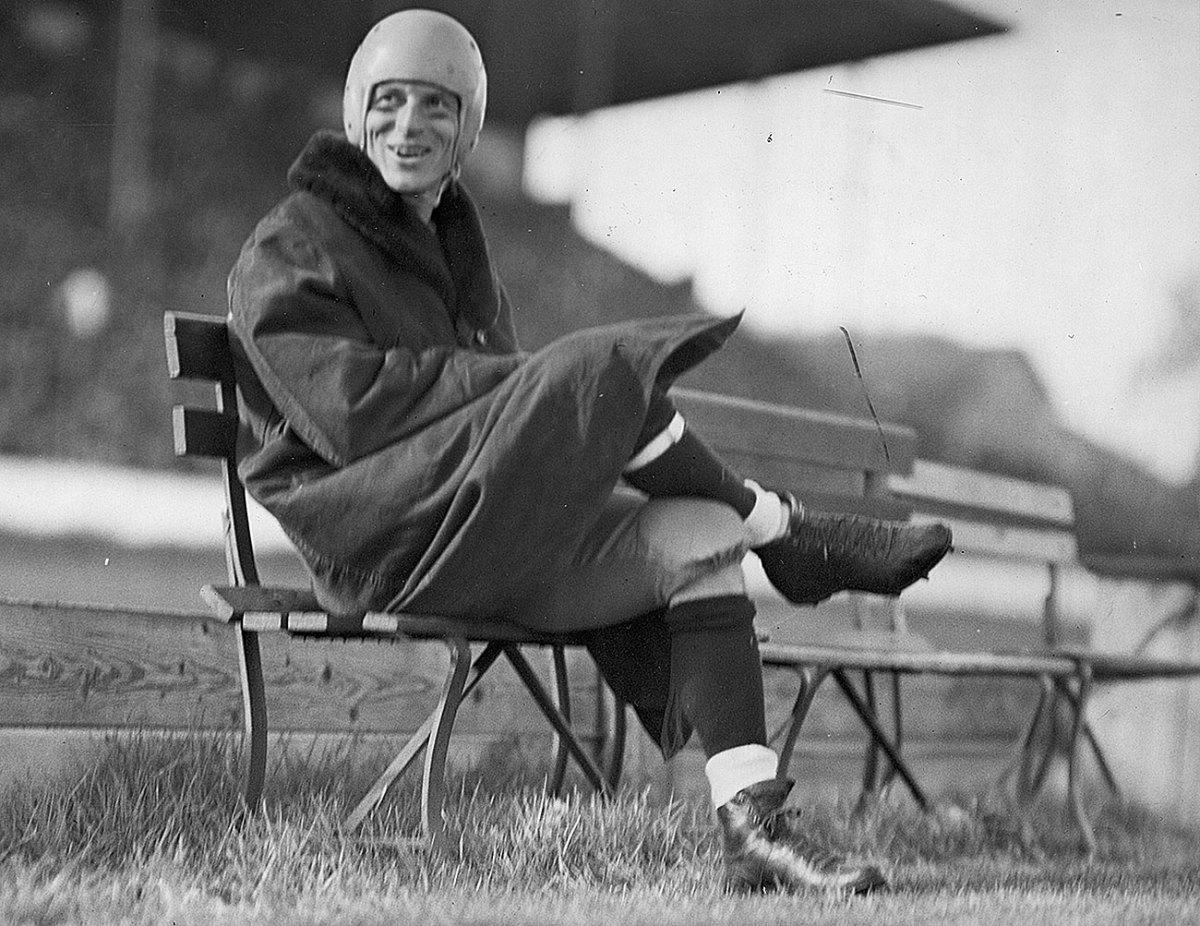
I watched Hutson in his early years, the 1930s, when he played left end on defense and would occasionally have to rush the passer. What kind of a rush did he put on? Nothing that would terrify you. On sweeps and traps he gave ground and did what he had to do without trying to unzip anybody. Later in his career they moved him to defensive right halfback.
His helmet rode high on his head, and he seemed a little awkward at times, an Ichabod Crane, until he was in full flight. Then he was a gazelle. He usually played the short side in the single wing, and when he lined up tight, he was a pass blocker, often having to face up to a defensive tackle, or an end, if he was coming.
“OK, T.O., on this play you’ve got to square up against Julius Peppers. Think you can handle it?”
I watched Hutson take down one of those big guys with the strangest looking block I’d ever seen. He threw a head fake, turned his back, flipped one leg in the air and made contact with his butt and back, a sort of reverse-reverse-body block. My God, I thought. What playbook did that come from? But his guy dropped. I saw him go back into coverage and break up a pass, and I saw him intercept one, and then on the sixth play of the first reel that I watched, there it was. The play that was worth the trip.
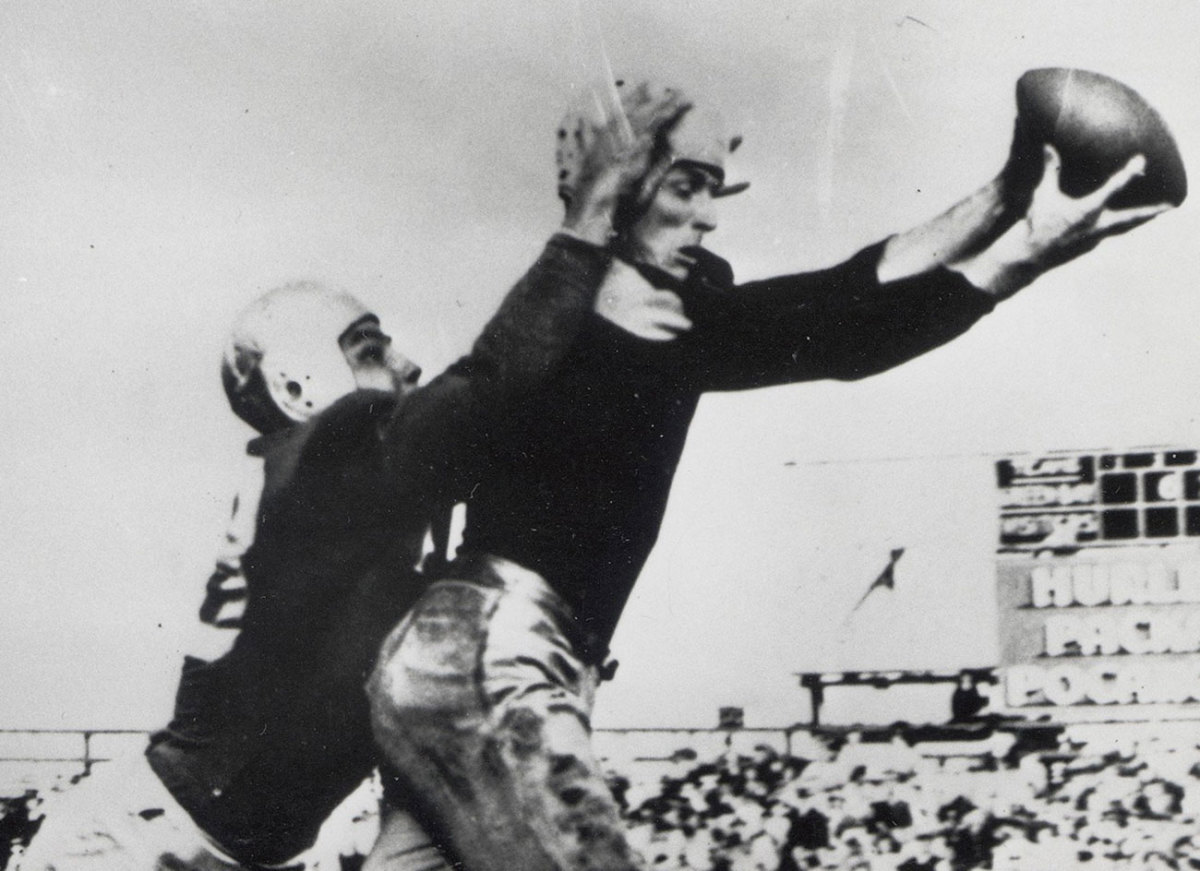
The Packers were playing the Giants. Clark Hinkle, scrambling, threw an option pass, sidearm, with two defenders in his face. Hutson was running a down-and-in. The ball was wide of the mark and high. He went up, the Giants’ Tuffy Leemans went up with him. Hutson did a scissors kick in the air and kept going up ... up ... and stayed up, like Michael Jordan. He reached, and with his body fully extended he snatched the ball away from Leemans, came down running and glided in for the score, a 62-yard touchdown. It was over in an instant, smooth, quick, decisive. Eleven years of that. Ninety-nine touchdowns.
I watched Hutson outjump two or three defenders, Randy Moss-style, on goal-line fades, catch deep passes so smoothly you couldn’t believe it had happened.
Two plays later Hutson ran a deep sideline route. Tailback Cecil Isbell’s pass was behind him. The defensive back was screening him off. With his momentum carrying him the other way, Hutson reached back, reached, reached—his arms seemed five feet long—reached past the defender, made his catch, kept his balance and scored. I ran the play back, frame by frame. It was an impossible catch. I’d only seen one other like it, Lynn Swann’s against the Cowboys in the ’76 Super Bowl, when his momentum was taking him out of bounds and he corkscrewed his body and reached back to grab the ball inbounds.
I watched Hutson outjump two or three defenders, Randy Moss-style, on goal-line fade patterns, I saw him catch deep passes so smoothly you couldn’t believe it had happened. I watched him toward the end of his career when they ganged him with two or three defenders and played aggressively and sometimes chopped him down at the line. And still he led the league every year.
How did he rate, all-time? Well, I watched that footage in the summer of 1989. Jerry Rice had been in the league for four years, and you knew he was great and would get greater, but no one could predict that he’d wipe everything off the books. Hutson wasn’t a technician like Raymond Berry, the finest possession receiver I ever saw. He was more like Lance Alworth, the same explosive speed, the same hunger for the ball downfield, a monster at the point of the catch. And then the smooth glide as he raced for the end zone. I didn’t have the heart to rate him above Alworth. As a young writer covering the AFL and rooting hard for its teams, I had seen Bambi simply tear up that league. No, in 1989 my two greatest receivers—Berry and Alworth—became three. Four now, of course, with Rice filling out the set.
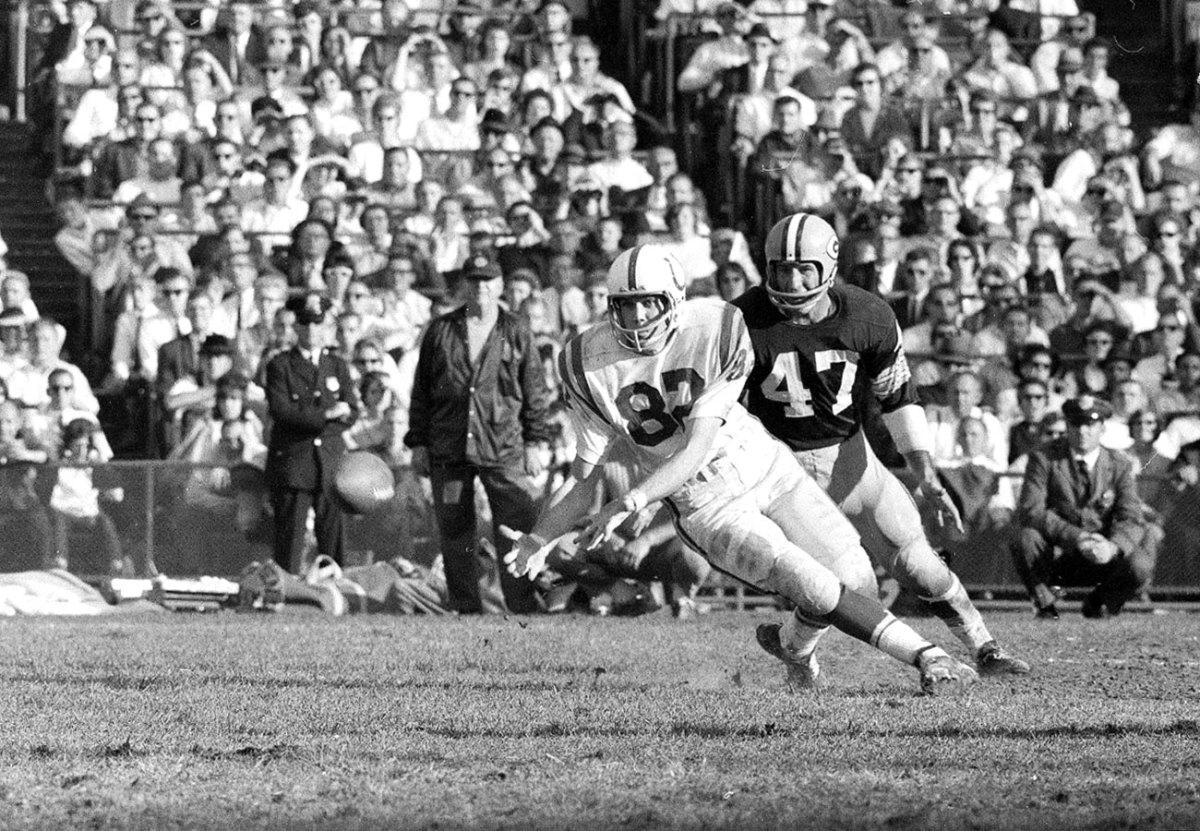
Raymond Berry had done it for me with one play in the days when he and John Unitas were hot, in the late 1950s. Of course we always read about Berry’s meticulous attention to detail and how he would walk the field before the games and note every irregularity, and the many hours he and Johnny U. worked together. But one play put a picture in my mind that I never forgot.
It was in 1959, the year of my first newspaper job, on the Sacramento Bee. We used to go up to San Francisco on Sunday and sit in the end zone and take our shirts off and drink beer and yell our heads off for the Niners. Right under where I was sitting, the Colts had a second-and-goal on the 49ers’ seven-yard line, and some sort of instinct told me to hold my binoculars steady on Berry and not to look at anything else on the field. In the next 2.5 seconds or so I saw a tableau that still is so vivid in my memory ... the perfect coordination of passer and receiver.
Berry ran straight at Abe Woodson, the right corner, and launched himself at Abe’s knees in a head and shoulder block. Abe, figuring some sweep was on the way—there must have been some play action simulating a sweep—fought to get Berry off him. Then, in an instant, Berry turned and hooked to the inside, and Unitas’ ball was right there as he hooked. Touchdown. Six points. And the 49ers fans gave poor Abe a tremendous booing. What the hell was he doing a yard off Berry anyway? Perfection. Couldn’t do it any better. He and Johnny U. put together 13 years of that.
One story about Berry I have to tell. I’ve always loved it as kind of a capsule of how football people see the world, except that I never could find a place where it fit. When he was coaching the Patriots in the 1980s, some friends treated him to tickets to a Boston Pops concert, to celebrate the team’s Super Bowl season. Afterward they asked him how he’d liked it.
“You know the greatest thing about it?” he said. “All those musicians playing their instruments, and everyone just leaves them alone. There’s no one coming along whacking them in the head, trying to mess them up, trying to mess up their timing.”
Two of the prettiest sights in the game were Alworth running the deep post and Jerry Rice running the shallow cross, splitting the field like someone cutting a piece of pie, turning a five-yarder into plus-50. Bill Walsh called it “athletic arrogance.” Rice called it confidence in a quarterback who would always put the ball exactly where it had to be, in front of him.
“I was blessed by having two Hall of Famers, Joe Montana and Steve Young, throwing me the ball,” he said. “The whole idea when you’re running any route, but especially the short crossing pattern, is to know that you’re not going to have to break stride or reach behind you for the ball. If I’m watching a game and I see something like that, I have to turn away. You see a guy hitching up or turning back for the ball and you know something terrible’s going to happen, with those DBs cruising back there like sharks. I was lucky. Joe was a quarterback who’d never hang you out to dry, maybe the best who every lived, leading you on the short cross. Steve came pretty close to that level.”
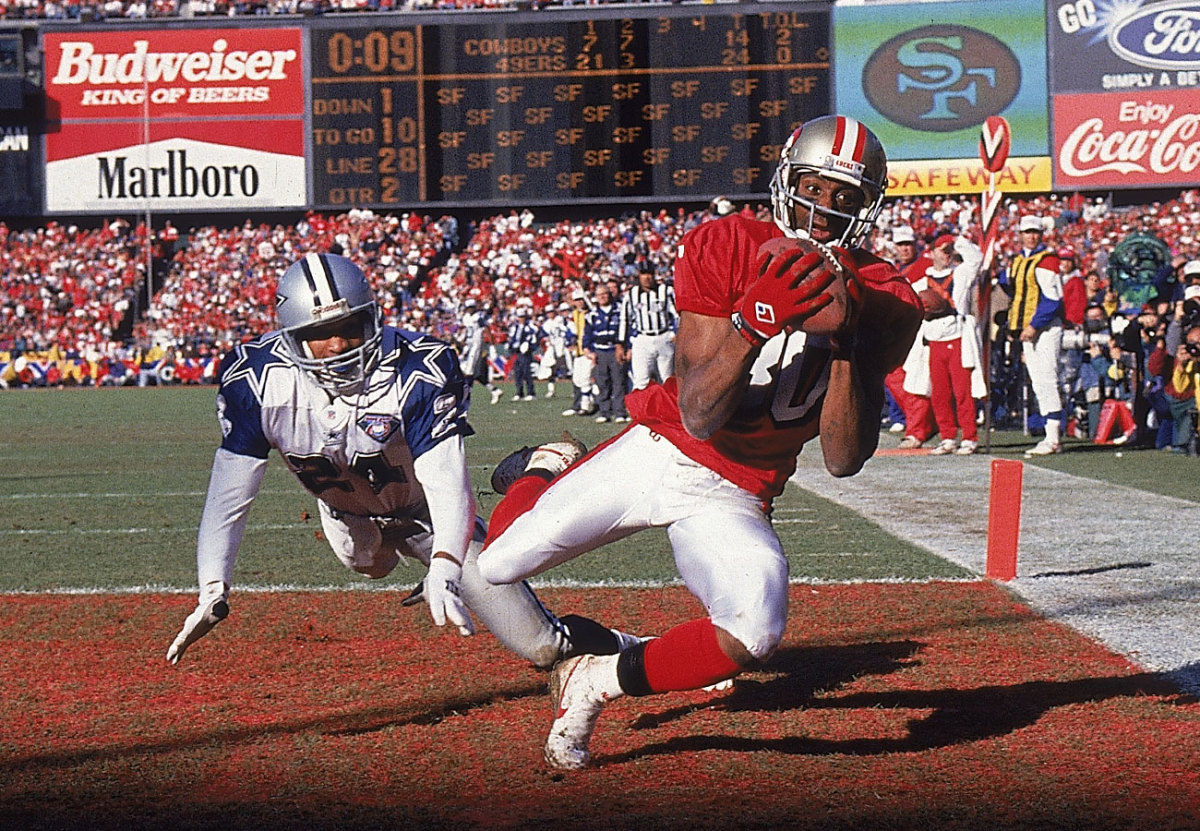
It’s too bad, at least for football voyeurs such as myself, that Rice chose to drag his career out forever, because there are young fans who will always remember him as he was toward the end, who never will have seen him in his prime. But what the heck, he certainly earned the right to play it any way he wanted to. Especially after such a rough beginning. Coming out of college, his speed was suspect. The scouts clocked him in the 4.6 range, and even in 1985 that was a little slow for a potential first-round choice.
“The trouble with scouts,” Bill Walsh said, “is that they don’t time people in game situations.”
And then, in his first year with the 49ers, he started dropping the ball. Now people really got worried. So did Rice. And then, in the space of a year, he just cured it. Worked through it. The thing I’ll always remember about him is the smoothness with which he did things, the incredible ease. Year after year.
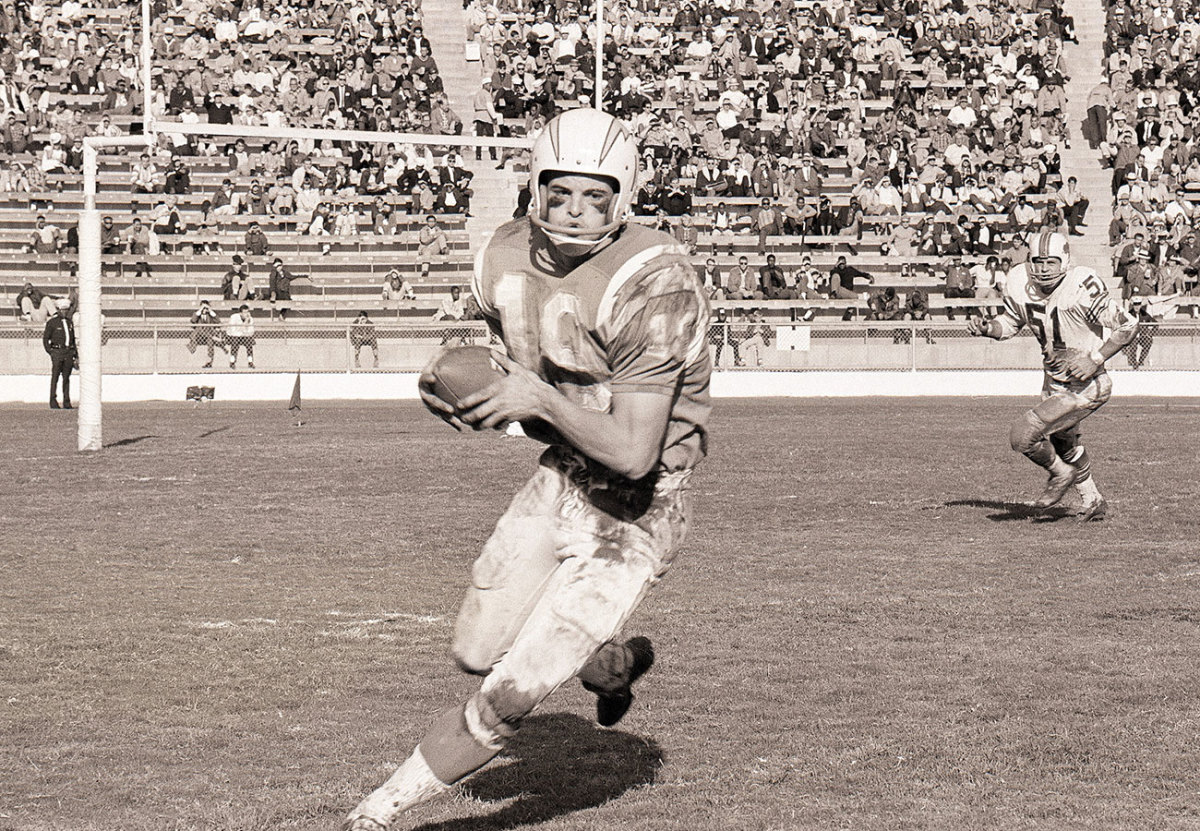
And the thing I’ll always remember about Lance Alworth was my feeling that somehow a child had become trapped inside him. I remember telling him something that Jets’ receiver George Sauer once told me, after I’d seen him catch five square-outs on a single drive and I asked him what was to keep him from catching 20 of those six- and seven-yard outs, as long as the cornerback was playing off him.
“You couldn’t take it physically,” he said. “Your ribs wouldn’t hold up.”
“Oh man,” Alworth said when I told him what Sauer had said. “I wish they’d throw ME 20 passes a game.”
“He always wanted the ball,” his coach, Sid Gillman, said. “He never got it enough.”
“He first showed up in our office in June, looking for an apartment,” said Al LoCasale, who worked in the Chargers front office in the early 1960s. “He had a skinhead haircut. He looked 15 years old. I heard my secretary, Barbara, tell him from the next room, ‘We’re not giving you the money because we’re not getting the paper.’ She thought he was the newspaper boy.”
* * *
ALL-TIME TEAM: TIGHT END
I have learned one thing in my two decades as a Hall of Fame selector. Don’t talk too much, otherwise what you say becomes meaningless, just more waves washing on the beach. That’s especially true when you’re isolating someone, for emphasis reasons, as the “best I’ve ever seen at the position.” You can use that one, maybe once a year, for one player. Any more than that and you become a parody of yourself. So who have been my “best I’ve ever seen” guys at the Selection Committee meetings? J.J. Johnson, the cornerback: Dwight Stephenson, the center; John Hannah, the guard; were a few who made it. Cliff Harris, the safetyman; Tommy Davis, the punter; Richie “Tombstone” Jackson, the defensive end, were some who didn’t, and I’ve just about given up on the last two. In 2002 my “best I’ve ever seen” was Dave Casper, the tight end.
Yes, indeed, John Mackey had been terrific, dynamic, an explosive force, but he had already been enshrined. I didn’t have to worry about him. In making my argument for Casper, I mentioned that he never dropped the ball. Mackey had had occasional bobbles.
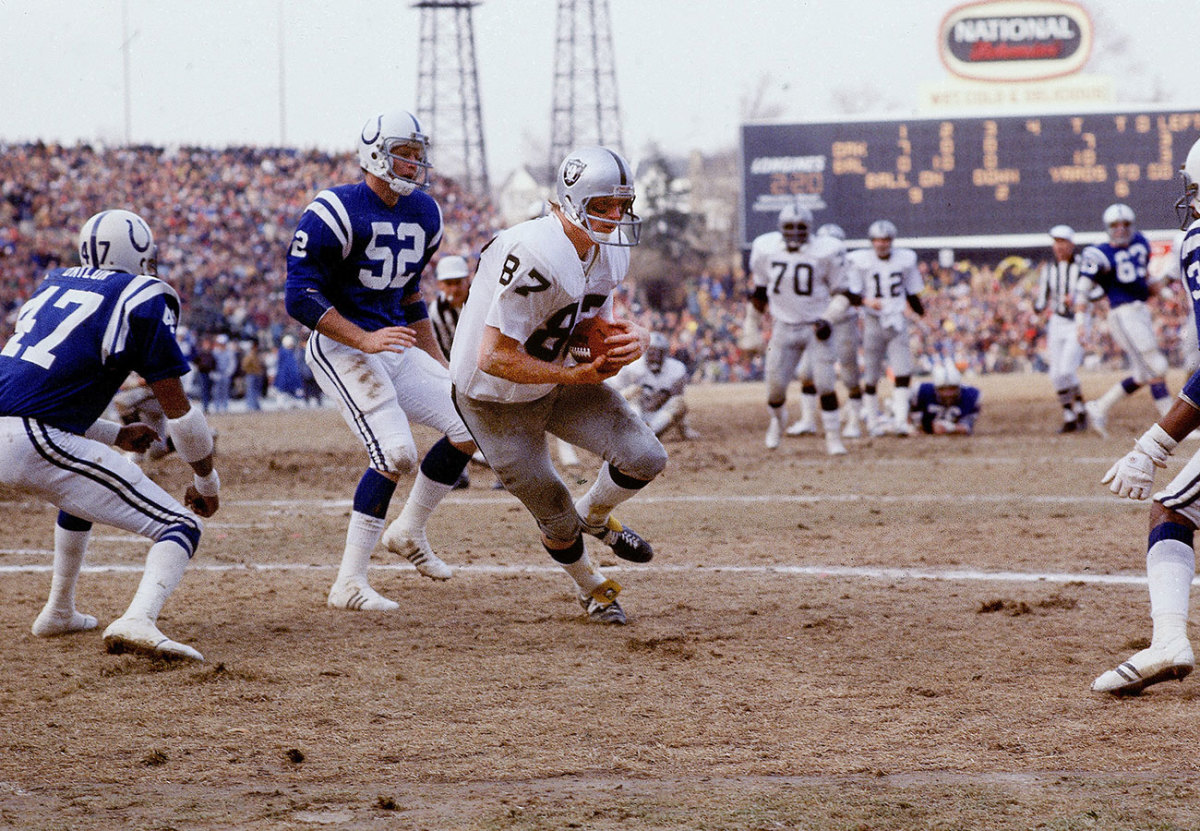
Casper had been a tackle at Notre Dame. You think those guys know how to block? No tight end ever had those credentials as a blocker. And Casper came up in the era of the down-the-field chuck, before the rules were loosened to protect the receivers. How many times had I seen him absolutely mugged on his patterns? And to combat the argument that he wasn’t really that much of a downfield threat, I pointed to his 13.8 yards-per-catch average, better than the keynote tight ends of ’02, Tony Gonzalez and Shannnon Sharpe, better than that of Kellen Winslow, who’d been recognized as a serious figure running the deep seam routes, and to jump eras, better than Antonio Gates, the current king of the TEs. Well, Casper made it, I’m happy to report. Wish I were so lucky with some of my other guys.
He was an unusual person, given to outlandish statements, usually delivered with an “I’m only telling you what everybody already knows” kind of indifference. I was talking to him in the locker room once, shortly after he had gone from the Raiders to the Oilers. This was after an exhibition game against the Jets. He was tying his tie, and was about to leave, when a kid from the student paper at Hofstra University, where the Jets had their camp, asked him, “What do you think of Ken Stabler?” who’d been his QB on both clubs.
“The Snake?” he said, putting a final knot on his tie. “I don’t think he’s ever studied a game plan in his life. He probably just throws it away as soon as he gets it. I’m not even sure that winning or losing means much to him; he’s more interested in the game he can play against the defense, how badly he can sting ’em.”
The kid was writing all this down like mad, and all of a sudden it dawned on me, “Holy hell? I’ve never heard this kind of stuff from a Raider or former Raider in my life.” And I whipped out my notebook and began scribbling away. Innocent question from a young reporter, dynamic answer. That was Casper.
* * *
ALL-TIME TEAM: TACKLE
They have compartmentalized the offensive tackle position. Form two lines, please. Toe dancers on the left side, hogs on the right. Trying to get a left tackle to get down and do some serious drive blocking ... why, that’s like trying to hitch a racehorse to a plow. Quick feet are what’s needed, quick feet ... God, I’m tired of hearing that phrase. It’s like they’re describing kickers, or Thai boxers. So you will see high on the first round of the draft, dance masters, such as the Jets’ D’Brickashaw Ferguson, whose flying feet will keep him in step with the right-side speed rushers, many of whom are really linebackers with a hand on the ground, but on running plays might wind up being driven four yards into his own backfield. Oh sure, there are exceptions, such as Baltimore’s gigantic LT, Jonathan Ogden, whose drive blocking is better than his pass protection, but they are exceptions.
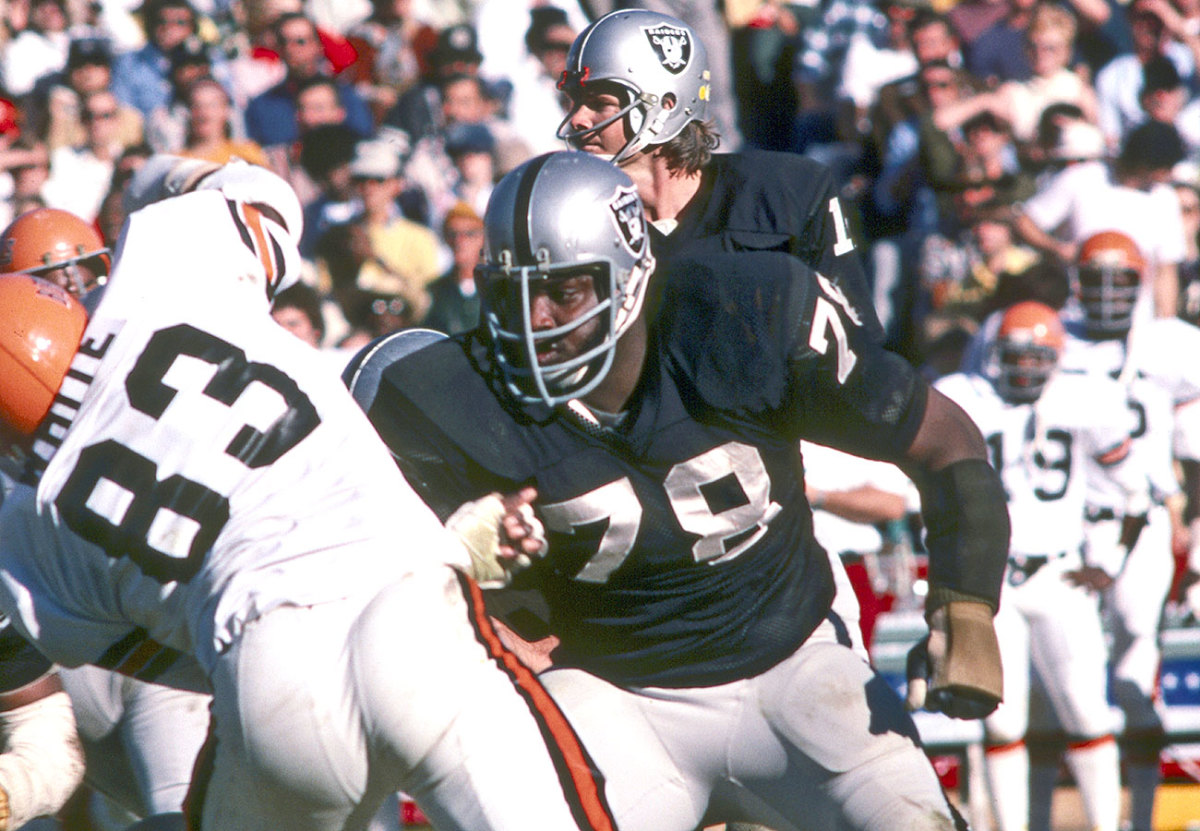
And on the right side, well, you’ll find players with more girth, except in the wallet department, because bangers don’t get paid as well as dancers do. You’ll find sturdy people, but they’ll be lower draft choices, or perhaps failed left tackles, or guards that just morphed over from their regular spot. Honest citizens who can block for the run but might need a bit of help if they’re lined up against speed rushers.
Thus, one of the toughest positions for me to fill on my annual All-Pro roster is offensive tackle. Usually I wind up with the players with the fewest negative grades, not the real studs. But I’m tilted the wrong way, I’ve been told by scouts, because I’m instinctively drawn to people who can knock an opponent off the line, whereas it isn’t really the checkmate that’s desired in this ultimate NFL chess match, it’s a whole series of drawn games, ties, pass rushers who are nullified.
So my eyes wander nostalgically toward the past, where my No. 1 tackle is Art Shell, the Raiders’ Big Brahma, oversized at 300 pounds in an era of 260-pound linemen, dynamic coming off the line, impregnable as a pass blocker.
“Came at me like a freight train, first time I faced him in practice,” Howie Long said. “Busted my cheek open, gave me a scar I still have.”
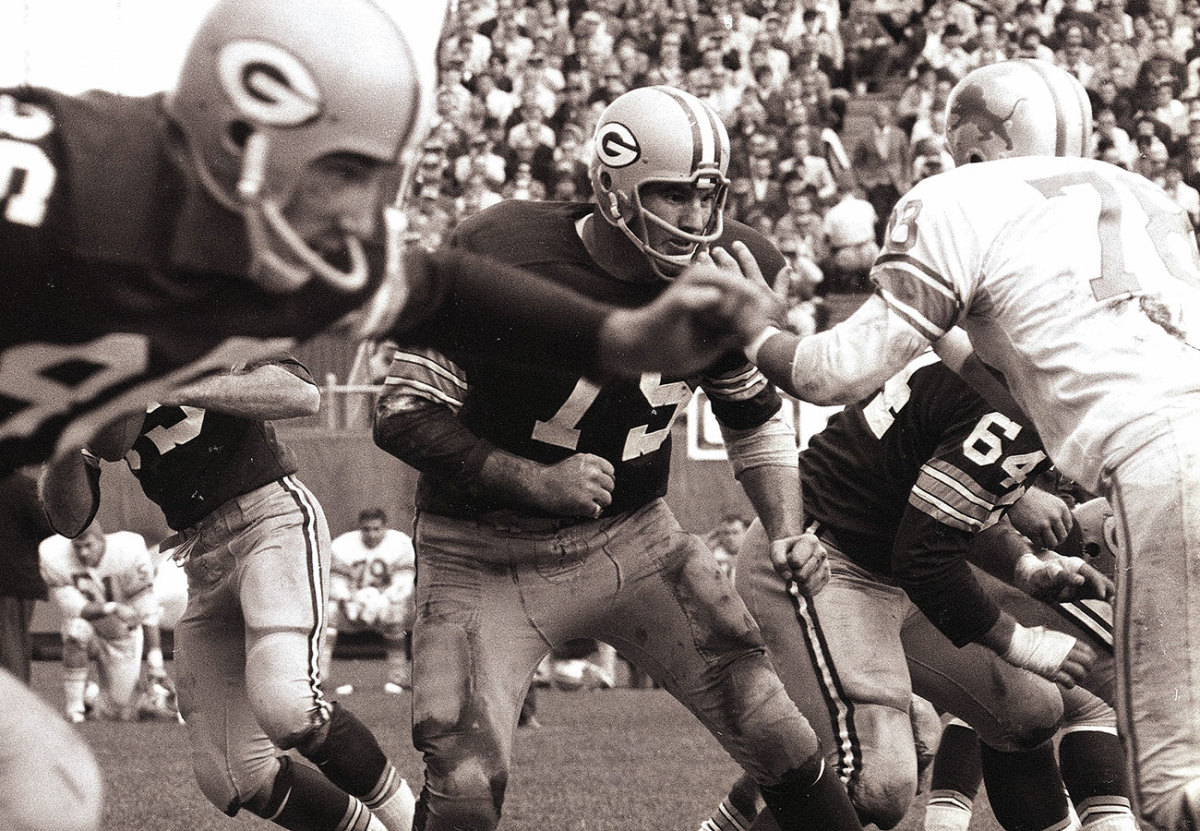
And here’s the odd thing; Shell played the left side. OK, you could say that he blocked for a left-hander, Kenny Stabler, for most of his career, but he was the LT before Stabler was around. He’s my power tackle. And the two speed tackles on my all-time team—and believe me, I tried to break the tie and I couldn’t—both played the right side, Ron Mix and Forrest Gregg. But that’s the way it was in those days. The best tackle played the right side because the best defensive end was lined up left—Gino Marchetti, Willie Davis, Deacon Jones, Richie “Tombstone” Jackson, etc. Best against the run, best against the pass...they had no designated weakside rushers in those days. So why was Shell on the left side? Because the Raiders always were a left-handed running team. It was part of Al Davis’ philosophy.
Mix and Gregg were lean 250-pounders, skilled, smooth, a pleasure to look at for an afternoon. Watching them was like a clinic. They could pull out, if they had to, execute any one of the intricate set of drive blocks they had in that era, lock on to the speediest rusher. “The most perfect football player I ever coached,” Vince Lombardi said about Gregg. Mix’s coach, Sid Gillman, toned it down a bit, merely saying that Mix was the finest offensive lineman he’d ever seen. Do I just sound old, reminiscing about these greyhound tackles while having to watch, every Sunday, 330-pound jumbos with 50 pounds hanging over their belts? Just one more story.
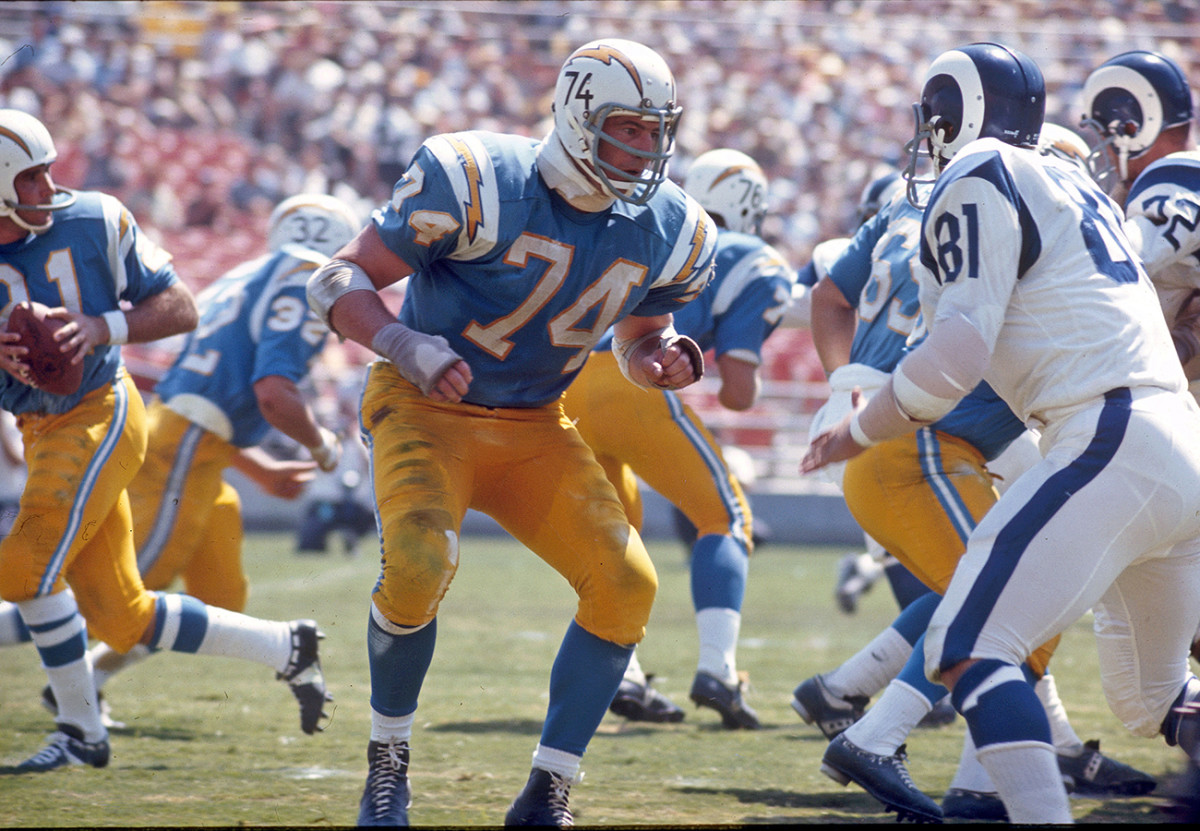
The Jets’ defensive left end, Gerry Philbin, was a mean, hard-bitten, undersized competitor who did it on desire and a persistent hatred of his opponent. He made it a point of honor never to talk to an opposing player.
“Come on, Gerry,” I said to him one day. “There must have been one time when you said something out there, I just know it.”
“OK, there was, but it was the only time,” he said. “We were playing the Chargers the year after we won the Super Bowl. I was putting on a rush, and Mix caught me just right and knocked me on my ass. As I was getting up, he said, ‘Hey, great Super Bowl, Gerry.’ I said, ‘Thanks.’ That was the only time I ever said anything. But you’ll notice that Mix did his job first before he said anything to me.”
* * *
ALL-TIME TEAM: GUARD
This was the easiest position on the board for me except for running back, where Jim Brown is unchallenged. I once wrote a piece for SI in which I called John Hannah the finest offensive lineman who ever lived. It was a very hard choice that I had to make between Hannah and Jim Parker, and I think if I had it to do over now, I’d choose Parker. It stirred up some controversy, which made my editors happy. A decent contingent of players who had had to line up against Hannah backed me up. The most sensible objections I heard also came from football people, some of whom said that you have to choose a tackle for that kind of designation, because the pass blocking duties were much tougher. I remember Mike Brown, the Bengals’ GM, held that view, as he lobbied for Cleveland’s great tackle, Mike McCormack, as the all-time number one.
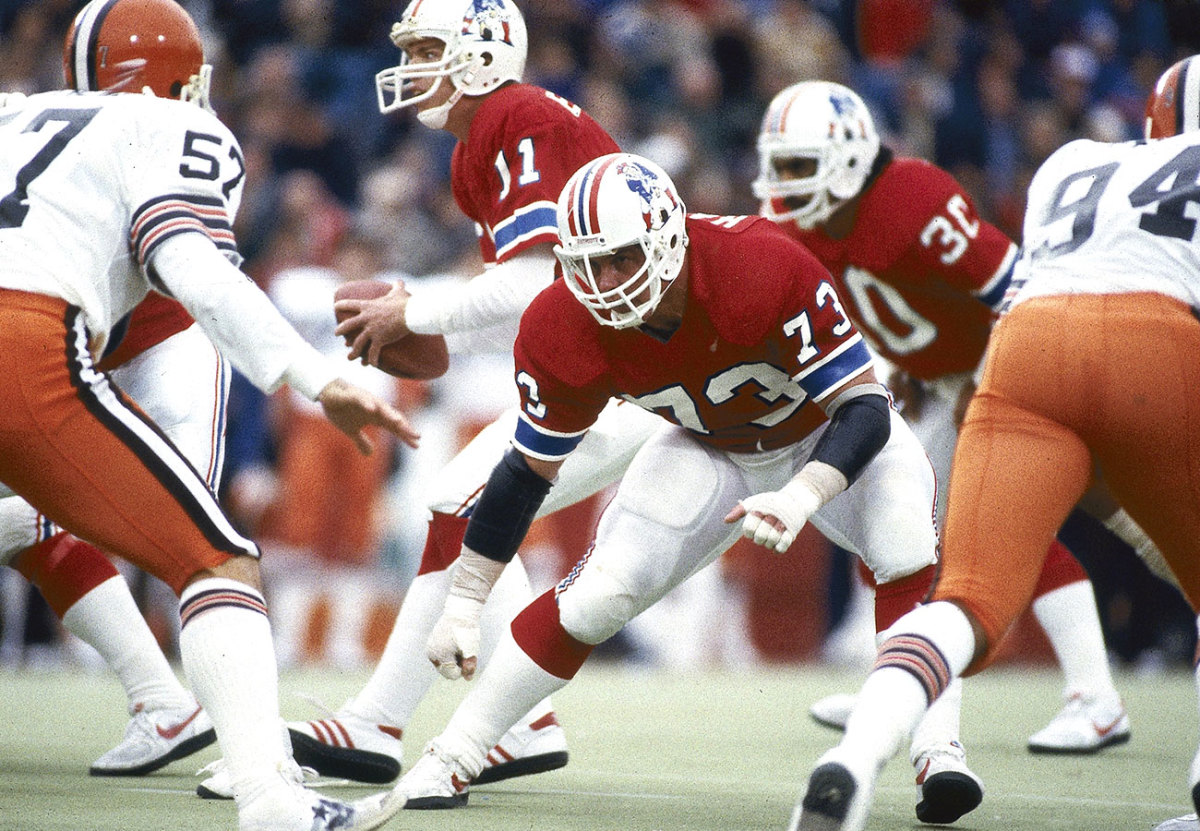
But maybe I’m just too seduced by the running game, by a lineman’s ability to dig down and get under his man and drive him off the TV screen, over and over again, and that’s what I saw Hannah do ... better than anyone I’d ever seen. And when you talk about pass blocking, in which Hannah certainly got stellar grades, who are the great pass blocking guards in history? Name them, please. A guard pass blocks in a phone booth, or at least in a fairly congested area. Now if someone were to ask me the same question I just posed, I’d hold up one finger. Jim Parker, greatest pass blocking guard who ever lived, and to strengthen the claim, just look at what he did when he moved one position to the left and lined up at tackle. The same thing, All-Pro as a guard, All-Pro as a tackle. Forced even the guys behind the TV cameras to isolate on him in the ’59 NFL Championship Game, when he gave an unforgettable performance against the Giants’ Hall of Famer, Andy Robustelli. After a while it became an item of fascination for the network, the lesson in how a tackle controlled a rusher, hailed as the first time TV isolated on this matchup, complete with replays.
Yeah, maybe Parker was the best lineman ever. At any rate, he and Hannah made my guard choices a slam dunk, which is always joyful duty for a selector. I visited Parker in Baltimore a few years before his death in 2005. He wasn’t well, and I’m afraid my questions didn’t make him feel any better. I asked him what he thought of the current standard of line play in the NFL.
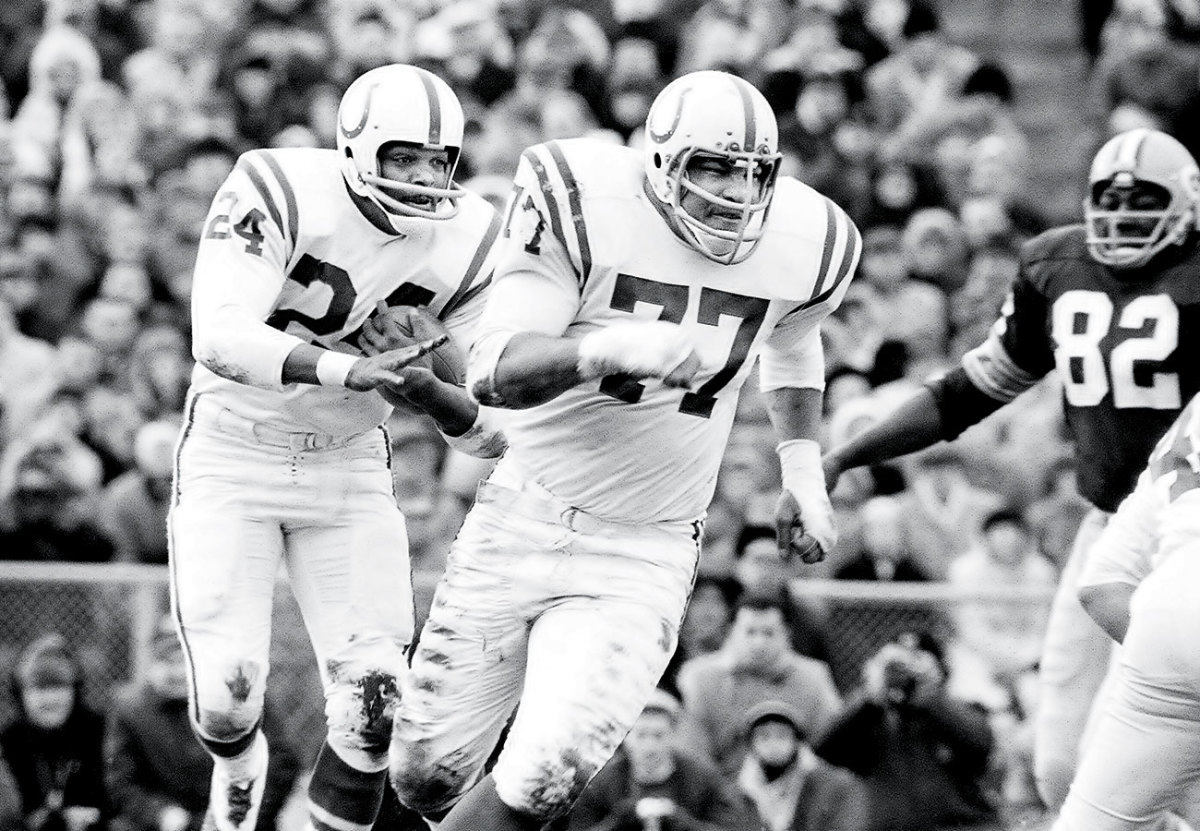
“Ooooh,” he said, grabbing his stomach. “Every time I think of that, I get this pain right here. I look at those techniques and what do I see? I see no technique. I see big fat slobs just playing slob football, pushing, grabbing, and then my stomach starts hurting again. Oooh, why’d you have to ask that?”
* * *
ALL-TIME TEAM: CENTER
Hall of Fame project number ... what ... for yours truly? Two, three, five? Dwight Stephenson, center, Miami Dolphins. Freddy Smerlas, the Bills’ nosetackle, was one of those guys of the opinion that no human being with a heartbeat could ever block him. Except for one.
“Dwight Stephenson was like no other center who ever played the game,” Freddy said. “You play against him, and it’s like you’re hit by a bolt of electricity. It’s like something just flashes through you. You never know where he’ll coming from.”
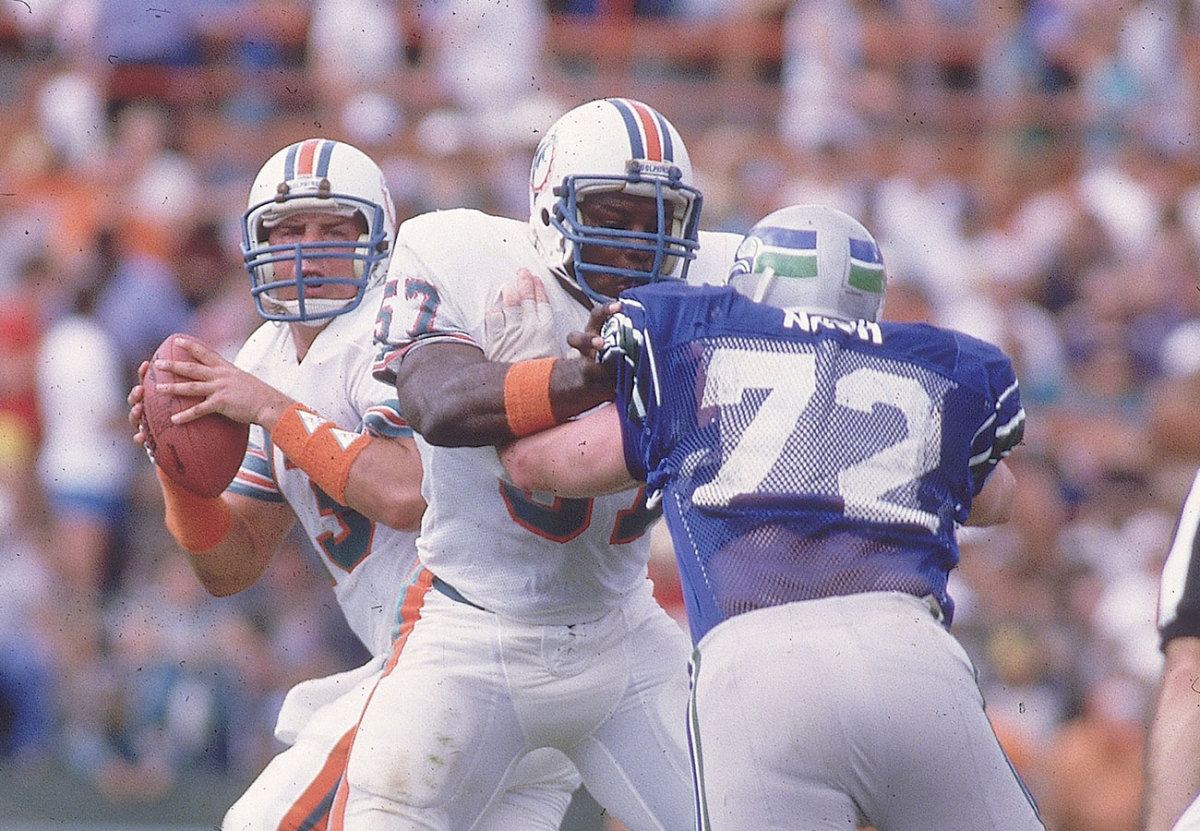
That was exhibit one in my argument for Stephenson at the Selection Committee meeting. Argument No. 2 was something Howie Long had told me. He said that when the Raiders faced him, their game plan was for Long to come down hard from his defensive end spot and crash Stephenson, to foul up his blocking angles and keep him from getting to the next level and nullifying a linebacker. It was like a wham block by a motion tight end, in reverse.
“You play against Stephenson,” said Smerlas, “and it’s like you’re hit by a bolt of electricity.”
“First time I’ve ever been involved with a game plan aimed at the opposing center,” he said.
Argument No. 3 was, well, the old standby, “Greatest I’ve ever seen at the position, “ which I hoped wasn’t wearing a bit thin, but what the hell, it was true. Stephenson made it down to the final six, when only a yea or nay vote was necessary, and he didn’t make it. I found out when I was driving back to my hotel, and when the news came over the radio, I got dizzy, literally, and had to pull the car over and stop. I mean who the hell had been the assassins who had dinged him at the very end?
“They’re like murderers in a dark room, hiding behind a door with guns in their hands,” I wrote, which is the kind of analogy you draw when you’re close to a mental breakdown.
Next year I asked for a show of assassins. Who are you? One fellow actually came forward and said, “The test of a lineman is longevity,” he said, “and Stephenson’s career only lasted eight seasons.”
“Jesus Christ,” I said, “can he help it if Marty Lyons came up behind him and took him out at the ankle and ended his career?”
Well, something must have kicked in because the next year he made it. Thank God.
* * *
ALL-TIME TEAM: QUARTERBACK
Some people have trouble choosing the greatest quarterback of all time. I don’t. As long as you understand that “all time” means split time. Old rules and new rules. Old rules meant a basic lack of rules when it came to protecting the passing game, which the NFL’s Competition Committee regarded as their Holy Grail after defenses such as the Steel Curtain Steelers threatened to turn the passing game into a mere memory. Defensive linemen could head-slap their way into the backfield and take down a quarterback any way they could, as long as they did it in fairly reasonable proximity to when he delivered the ball. Pass defenders could mug the receivers all the way down the field. Bump-and-run cornerbacks made the bump a real serious thing, not just a funny name. The Rams had a system called the Axe Technique, which meant chopping receivers down at the line, and then chopping them again when they got up. The Chiefs had a corner named Freddy “The Hammer” Williamson, whose modus operandi was a karate chop designed to stun his opponent.
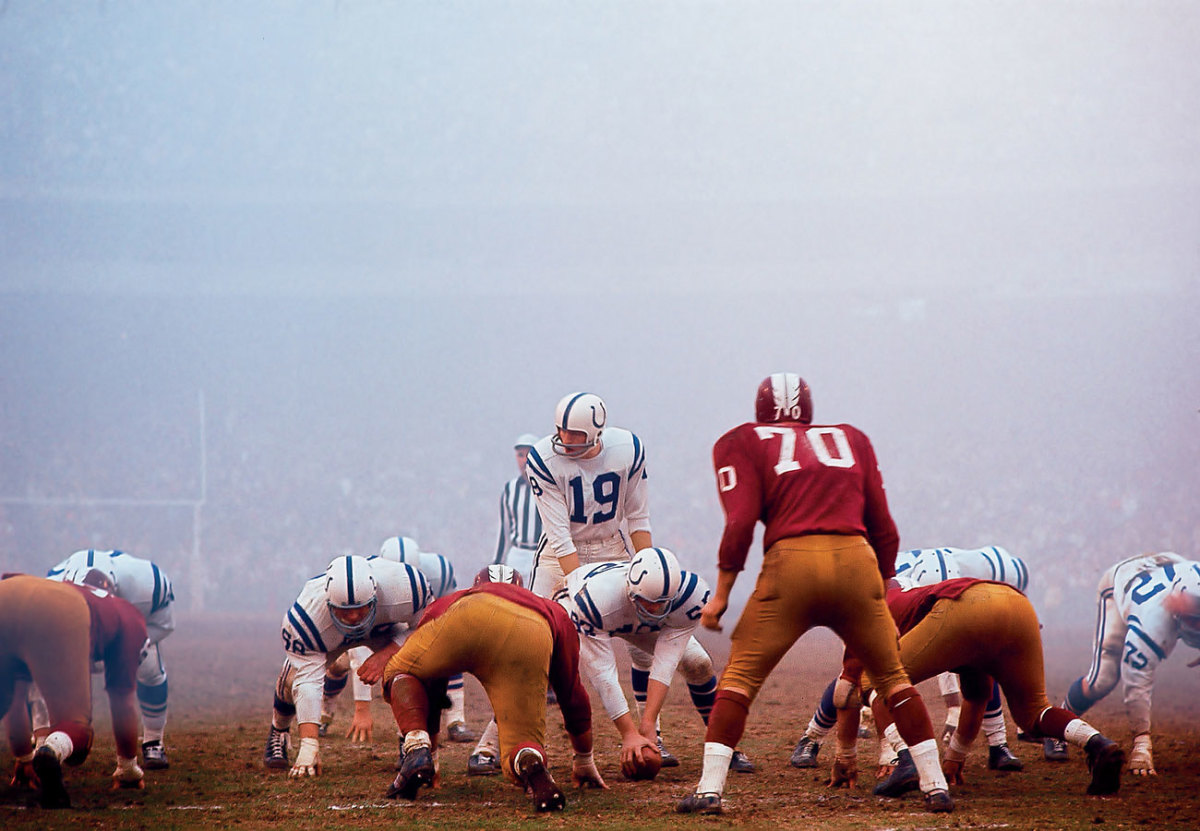
And in this world, which now appears primitive but seemed perfectly natural at the time, John Unitas was king. There had been many great passers in the league ... Sid Luckman, Otto Graham, Sammy Baugh, Norm Van Brocklin ... and some QBs who showed inspirational courage. Unitas was a combination of both. Then there were the supreme intellectuals of the game, the great play callers, exercising a skill that is now lost when everything is called from the sideline or the press box. Only a handful of quarterbacks call their own game now ... make that only one that I know of, Peyton Manning, and he is tightly wired to his offensive coach, Tom Moore. But in those days we talked of the great “Field Generals.” What would they be now? Field Lieutenants? Captains maybe? Dutiful followers of the chain of command.
Writers mentioned Johnny U’s genius on the field, the way he could bring his team back, time and again. Teammates and opponents alike talked about his toughness, his ability to function at the highest level under the most severe punishment. The stories have become legendary. The old Colts talk about the time Doug Atkins bloodied John’s nose, and Alex Sandusky, the guard, scooped up some mud and stuffed it up his nose to stop the bleeding, and the ref stuck his head in the huddle and said, “Take all the time you need, Unitas,” and Johnny U told him, “Get the hell out of here so I can call the play.” The Rams’ Merlin Olsen said, “I don’t know if I could do it, stand there week after week and say, ‘Here I am, take your best shot.’”
But that was then and this is now, and any defensive lineman so bold as to come near a quarterback’s head would first get a flag and then, probably, a hook and would watch the rest of the contest on the TV in the clubhouse. Quarterbacks are protected. So are receivers. And O-linemen. No more head slaps, no more mugging down the field, not too many bloodied quarterbacks, although it can happen in what are termed accidents.
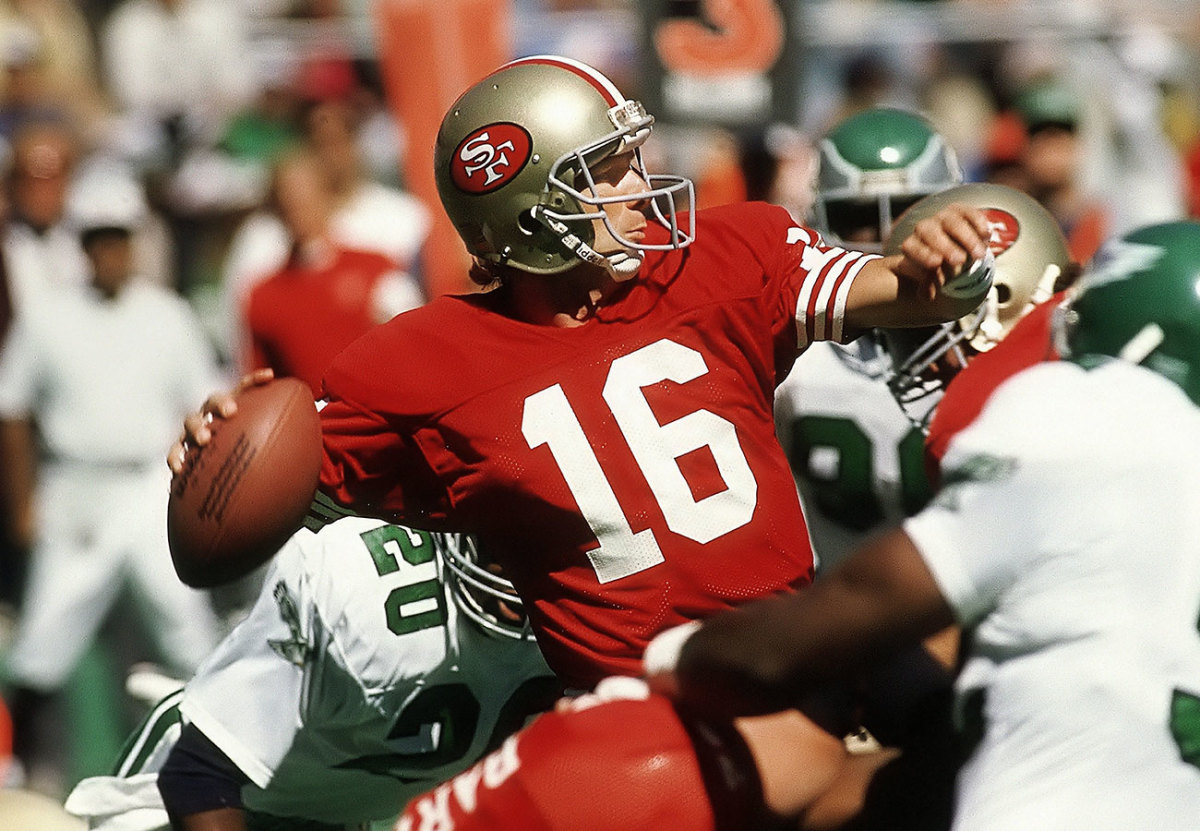
Joe Montana arrived at the dawn of the new era and played his career as the rules evolved into what they are now. He had the ability to bring teams back, as Unitas did. He never had to call his own game, certainly not with Bill Walsh running the show, and he never really had to absorb the punishment Unitas did. He was a better athlete. I mean Unitas never high jumped 6'9". Many of his most famous plays came at the tail end of some daring escape, most notably the touchdown pass to Dwight Clark that beat Dallas and got the 49ers into their first Super Bowl. Unitas’sd precision passes to Ray Berry were a thing of beauty, and he had great touch and accuracy on his long throws; Montana might be the most accurate short passer who ever lived, especially throwing the slant or the shallow cross.
I have been asked to select one of them as the greatest ever, and I can’t do it. Could Montana have played in an era in which toughness was at such a premium? Probably. Could Unitas function in today’s game, in which all calls came in from the sidelines? No. He would have been a coach’s nightmare, growling and cursing and changing up all the bench calls until the team either changed its methods to accommodate him or shipped him off to a rare bird such as Tom Moore, who would have geared the system to Johnny U’s rare ability to see things during the course of battle that the coaches missed.
“They’ve taken the game away from the quarterback,” is something Unitas told me many times. “The quarterback just stands there waiting for something to come in from the bench, and the team stands around, and ah hell, I just couldn’t have put up with that.” He spoke with passion and anger, and in that regard he was almost directly opposite to Montana, who always seemed to have an air of wonderment about him. So what’s the big deal, anyway?
Montana never seemed to quite know how he accomplished what he accomplished. It really was a game, after all.
The one thing they had in common, though, was the ability to raise their game to the highest level when the stakes were highest. When I asked asked Unitas about it, he’d just about reconstruct the situation, play by play, such as the winning drive in overtime against the Giants. There was even a certain anger in that... “Oh hell, anyone could see...” etc.
Montana never seemed to know quite how he accomplished what he accomplished. Once, when I was doing a two-part series on him for the magazine and I had what I knew would be my longest one-on-one shot with him, I worked myself into a near-frenzy trying to unlock the door. But how does it happen? How do you manage to lift your game, and then lift it again if you have to, until you’re right at the top when you’re under the most pressure?
He shrugged, smiled. I mean it really was a game, after all. They do say “play” football.
“I don’t know... better concentration, maybe,” he said. I felt like Macomber, the coward, in Hemingway’s story, “The Short, Happy Life of Francis Macomber,” when Wilson tells him, “Doesn’t do to talk too much about all this. Talk the whole thing away.”
“He never told you, did he?” said Matt Millen, who was Montana’s teammate toward the end of his career. I said no. “He doesn’t know,” Millen said. “He just goes out there, plays, completes passes, wins. It’s just so natural to him.”
* * *
ALL-TIME TEAM: RUNNING BACK
Unfortunately I never saw Jim Brown play football in college. I was in the Army, stationed in Germany, during his senior year at Syracuse. Which didn’t mean that I never saw him as an athlete. In Brown’s sophomore year I saw Syracuse play basketball in the Garden, and early in the game the first sub who came in for the Orange was a 6'2" guard with muscles in his arms like melons. Hmmm, now that’s an unusual looking basketball player. I saw him take a charge, and the guy who tried to run him over bounced once and wound up on his backside. This was who? Oh yes, Jim Brown. Then it clicked. I said to my buddy, “Isn’t that the guy from the Manhasset on the Island, the one they said was the greatest high school lacrosse player in history?”
“Yep, that’s him,” he said.
Brown was a bruising 220-pound fullback in college. At least that was his reputation. In the NFL he was a whole lot more, of course. He weighed 228 and ran with the grace of a jungle cat ... until he smelled his prey. Then he would strike quickly with explosive force. He never missed a game. He retired at 29. His running skills have been documented so many times in so many ways that there is very little to add. I covered him only once in a locker room, in 1963, when I was writing an opposing team sidebar on a Giants-Browns game in Yankee Stadium.
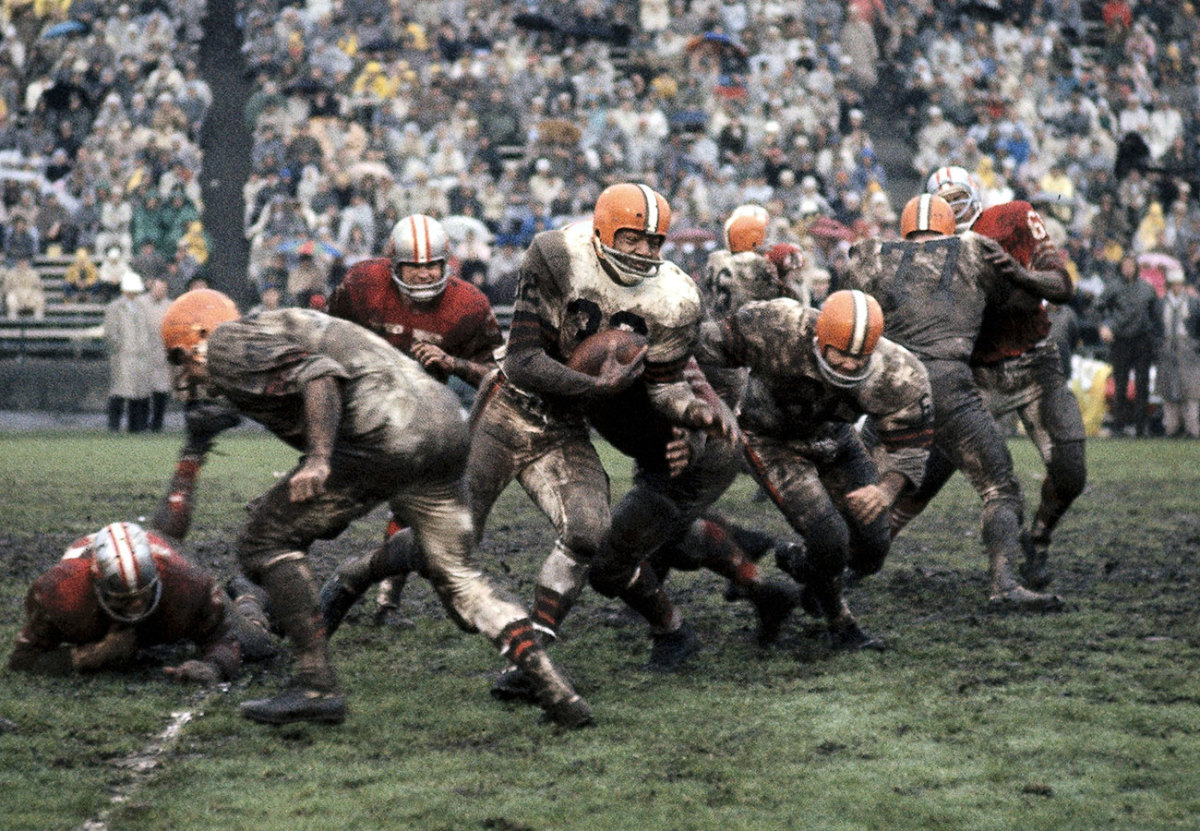
He was standing on a bench, talking to a small semicircle of writers. He had run for 123 yards and two touchdowns in a place where, traditionally, he had had problems. He had his head tilted back as he answered their questions, coldly, arrogantly. He was literally looking down his nose at them. He had just come out of the shower, and water was dripping on their notes. I didn’t like the looks of this scene, so I decided to talk to the offensive linemen, Schafrath, Wooten, Hickerson. No one else came over. They were glib, funny, friendly, a pleasure to deal with. Folks, I think I’ve hit on something here.
I still remember the headline the New York World-Telegram put on my piece: “Don’t Forget those Toughies Who Clear the Way for Jimmy.” This is really apropos of nothing, except that it set me up for covering big games for the rest of my career. You don’t need to talk to the superstars to find out what happened.
Well, Brown is my walkaway choice for greatest runner ever. Any arguments?
One addendum: Give me a play to run on third-and-10, and I’ll go with the throwback screen to Hugh McElhenny. The King. A crazy legs, the Barry Sanders of his day. The play would give you minus-two or plus-40, but guaranteed, no one would forget it.
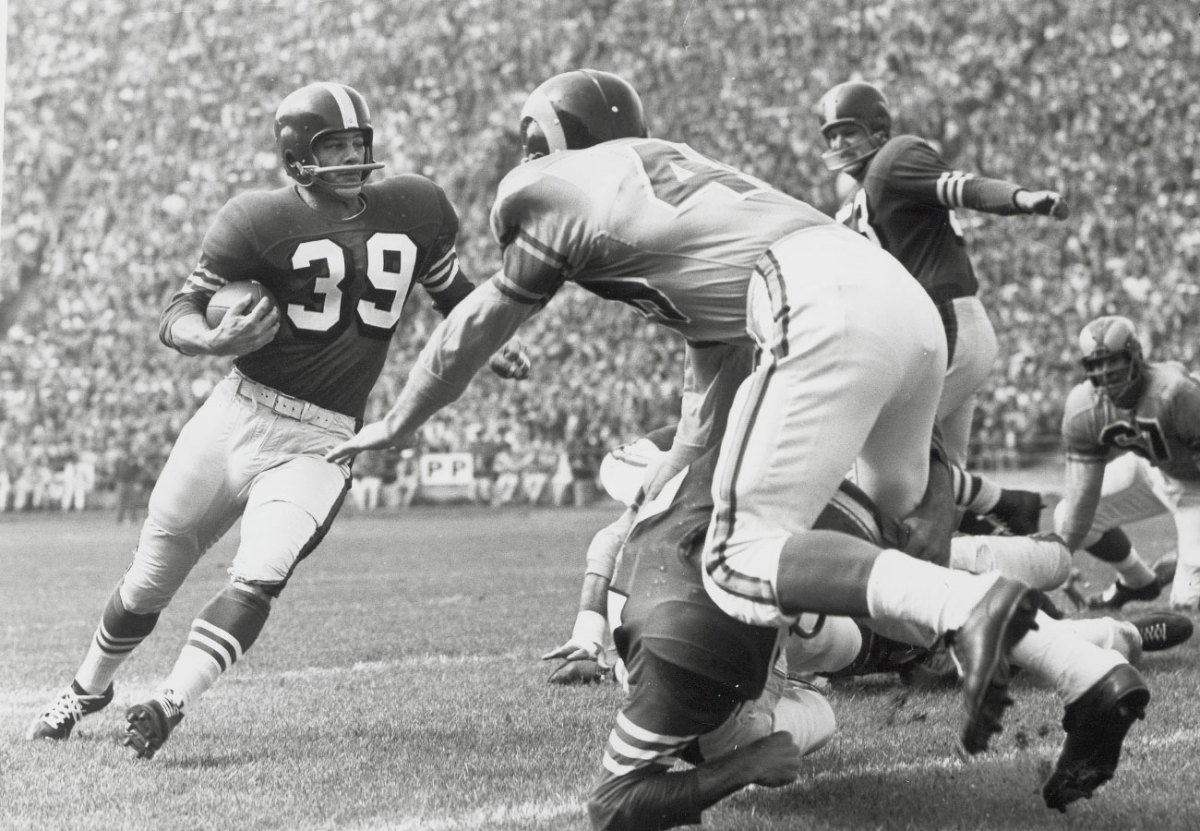
I’ve told the following story so many times. It became a chapter in my book, The Thinking Man’s Guide to Pro Football, and the chapter was labeled “Strictly Personal: The Greatest Player.” The player was Marion Motley, fullback for the Browns for four AAFC years and four full seasons in the NFL. I originally wrote the book in 1968, kept the honor going when I did the revised Thinking Man’s Guide 15 years later. Now, in my old age, I’ve learned to shy away from flat out pronouncements such as that one. I mean, can I say that he was better than Jerry Rice or Reggie White or Lawrence Taylor or Jim Brown or Joe Montana or John Unitas? Well, I don’t think so. Maybe I’ve undergone a deconditioning process by reading so many lists by so many people who never saw even a handful of the players they’re trying to line up and rate, one through 10, or 25 or 100 or however many their editors tell them to rate. Naah, keep me out of that race and let me just say that Motley is my all-time No. 1 fullback and a terrific competitor. But the story of my attempt to track him down for my “greatest player” chapter bears repeating.
I first saw Motley through the eyes of a 14-year old, eyes that grew wider with each viewing. That was the Motley of the All-America Football Conference, a player not many NFL followers saw, because when the Cleveland Browns were merged into the NFL Motley was 30 years old with two bad knees. He was a shadow of the old Motley, but he still was good enough to earn All-Pro honors, which might be an indication of what he had been in his old AAFC days. I’ve deliberately tried to keep from cluttering up this section with statistics, but I’ll make an exception for Motley and give you just a taste of what his rushing stats looked like in his four years in the AAFC, not receiving, although he was effective enough on the screen and swing passes to average 14.3 yards per catch from 1946 to ’49. To put this in perspective, Gale Sayers averaged 11.7 for his career, O.J.Simpson 10.6, Jim Brown 9.5, Walter Payton 9.2, Barry Sanders 8.2. Only three pure runners among the mob of backs in the Hall of Fame ever topped Motley’s average, and the leading pass-catching backs of the current era, Marshall Faulk and LaDainian Tomlinson, average 9.0 and 7.3, respectively.
Motley’s rushing figures were eye-popping: 6.2 yards per carry in the regular season and 8.6 in the playoffs. These are statistics for a will ’o the wisp 185-pounder. But Motley weighed between 232 and 238 in this period, plus he played situation linebacker on defense and blocked for Otto Graham in pass protection. That’s the way they did it in those days: Fullbacks took on the blitzers, and when they reached Motley, set four-square and big as a lineman, that was the end of the rush. Or as Weeb Ewbank, who was an assistant on the Browns in those days, put it, “Motley takes the romance out of the blitz.”
If you want to say, well, OK, that was against inferior competition, think again. The AAFC was every bit as good as the NFL. Everyone knows what happened when the champion Browns met the champion Eagles in the 1950 opener, one of the most meaningful games in league history. Browns, 35, Eagles 10.
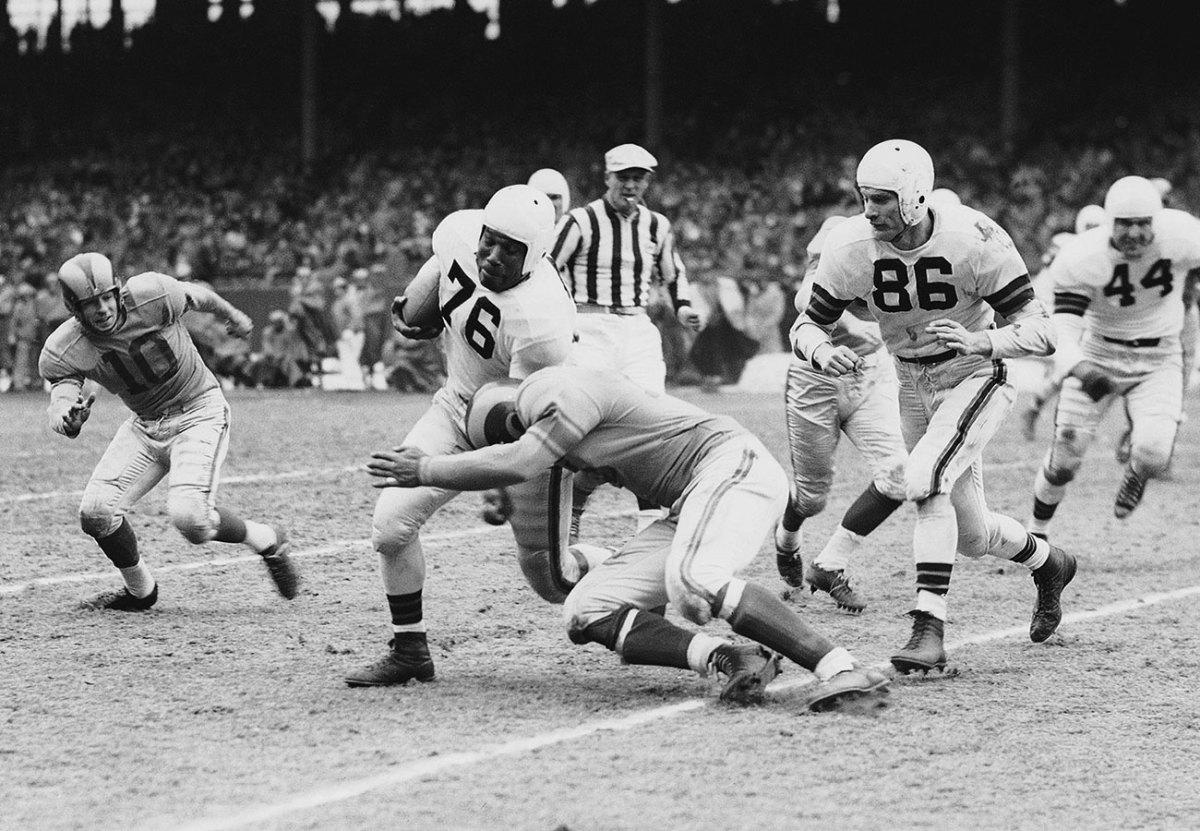
Well, I saw Motley in his AAFC glory days and sadly watched him as his skills gradually declined in the NFL, and by 1968 I had him squarely in my sights for the “Greatest Player” chapter. The problem was getting him to sit down for an interview.
He had been burned by Paul Brown, who had promised him a job on his staff and then stiffed him, burned by people outside the football community. He was gun-shy.
I finally tracked him down in Miami, during the week of the Jets-Colts Super Bowl. He was down there to help with a fundraising campaign for the NFL Alumni Committee, to try to get a pension installed for former players who were broke and needed help—the same battle as now, almost 40 years later. I made an appointment to meet him in his hotel. He was gone when I arrived. I rescheduled it for the next day. Again, gone. I was getting desperate. We were on to Saturday, with the game the next day. I made an appointment to meet him at 8 a.m. I showed up at 6:30. When I came to his room, he was putting on a green sweater, getting ready to take off for a golf tournament. I told him who I was and why I was there.
“I’ve talked to a lot of guys who said they were going to do stories on me,” he said, “but somehow I never get to see those stories. They say they’ll send them, but they never do.”
I didn’t know what to do. If I missed him that day, well, game day was out, then everybody scattered, and the chapter would be due. He was almost out the door. The only thing I could think of was to sound off in a pure stream of consciousness.
I told him I was in Kezar Stadium the day Norm Standlee tackled him near the 49ers bench and he crawled all the way across the field and out of bounds, to save a time out.
“Pulled a muscle in my leg on that play,” Motley muttered.
I told him I was sitting in the end zone for the ’47 championship game against the Yankees, when he ran 51 yards for a TD, right at me, with Harmon Rowe riding his back for the last 10 and punching him in the face. I told him I was in Yankee Stadium the day he knocked Tom Casey out of football. Casey had been a 175-pound defensive back for the Yankees, the only man I ever saw stop Motley, head on, when he had a full head of steam. He woke up in Bronx Veterans Hospital. He never played any more football.
Motley smiled. “I see him every now and then,” he said. “He’s Dr. Thomas Casey now, and he lives in Shaker Heights, right outside of Cleveland. We kid each other about that play. He’ll say, ‘You S.O.B., you ended my career.’ And I’ll tell him, ‘I couldn’t help it if you got in front of me.’ ”
He looked at me hard. “Young man,” he said, “you’ve got quite a memory.” And then, and the memory stays very fresh in my mind, he slowly peeled off that green sweater and lit a cigarette.
“Now what is it that you want to know?”
The interview went well and I got what I needed. I sent him an inscribed copy of the book, but, unfortunately, there’s only so much you can tell somebody, and how could I tell him that he was an early idol of mine, shortly after the death of Al Blozis, the record grenade thrower, that I had seen that incredibly tough-looking picture of him in Pro Football Illustrated 1947 edition, with his lower lip sucked in and what looked like a scar running down one side of his face, and I had saved it for more than 20 years? The advent of the face mask created one interesting phenomen in football: It changed the aspect of players’ faces. It took away the real tough-guy look of the early stars. I mean do you ever see anybody nowadays with a face like Bronko Nagurski’s? What you see is a collection of baby-faced, weightlifting 300-pounders. Could I tell Motley that what I saw of him on the field was even tougher than that picture of him? Nah, not done, not cool. Better move along.
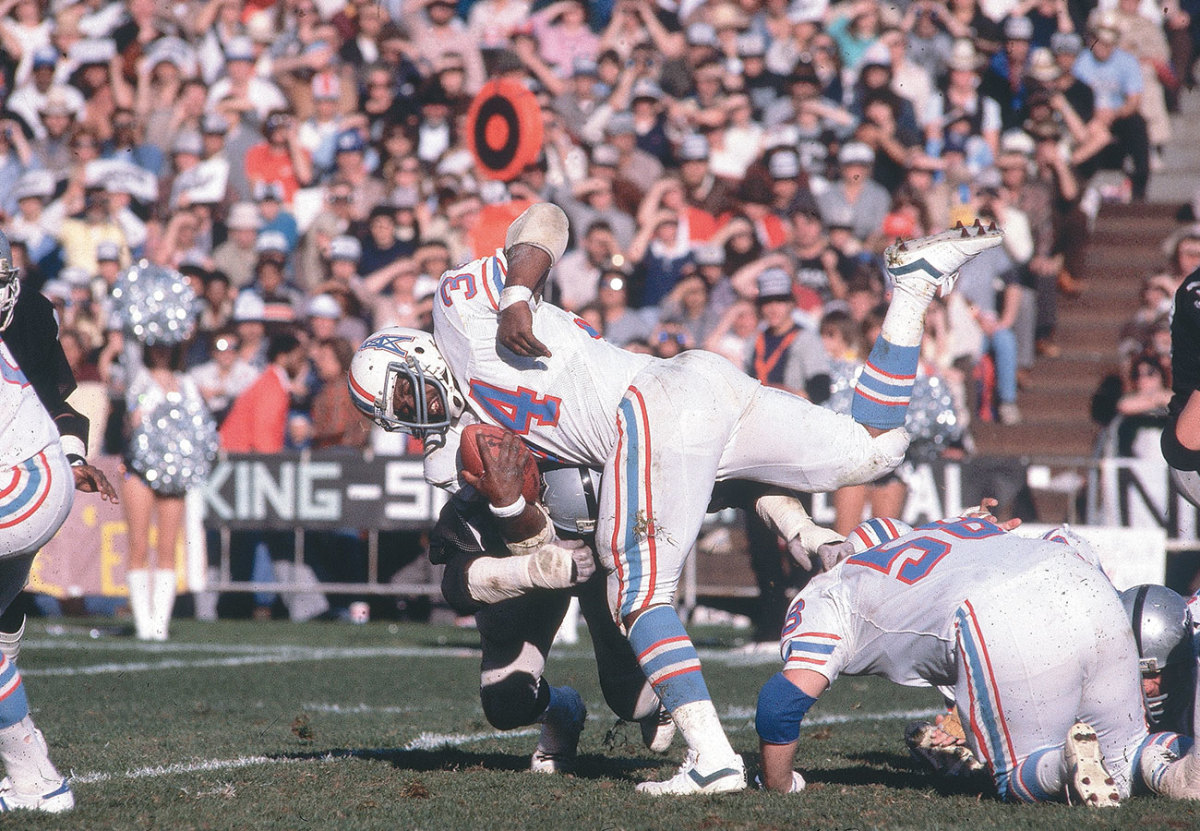
One of the saddest things you can say about a player, something that combines admiration with melancholy is that he “plays too tough for his body.” Usually the statement defines a runner, and it is marked by fearsome collisions. Larry Brown, the old Redskins runner was a perfect example of the species. So was Paul Hofer ... anyone remember him? An early Bill Walsh tailback on the 49ers, real kamikaze runner.
Neither of them made it past 29. But Earl Campbell did. He lasted all the way to his 30th birthday, and he was as ferocious as any of them—and bigger. He punished tacklers, they punished him. Today he can barely walk. But man, when he smacked in there with that amazing takeoff speed of his and his 240 pounds, bodies flew.
One of his most famous plays came against the Raiders, when Jack Tatum was the most feared hitter in football. It was a goal-line play. Campbell exploded into the line, Tatum took a run at him and met him full force, Campbell stiffened, made it into the end zone, held onto the ball and collapsed. Six points.
“Toughest play I’ve ever seen by a back,” the Raiders’ strong safety, George Atkinson, said. “Man scored a touchdown when he was unconscious.”
Read Part II of Dr. Z’s All-Time Team—Defense—Thursday at The MMQB. And send your comments to talkback@themmqb.com.
